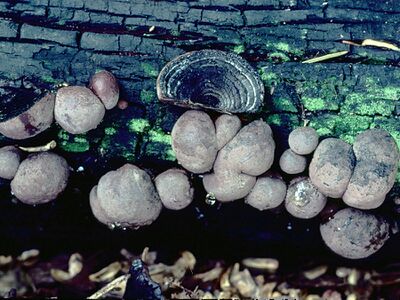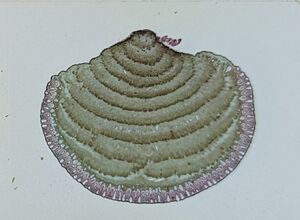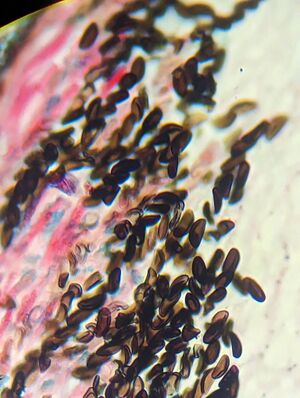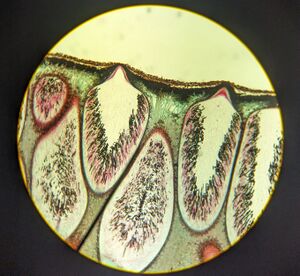User:Anaandrade
Daldinia
Daldinia is a genus of endophytic fungal species from the family Hypoxylaceae in the order Xylariales. The genus was named in 1863 by the Italian mycologists Cesati & De Notaris, after Agostino Daldini who was a Swiss monk, clergyman and botanist. It is known by several common names such as cramp balls, coal fungus, and King Alfred’s cake.
The latter nickname is common in Britain where according to legend, the late King Alfred the Great was fleeing a battle and took refuge in the house of an older woman. The woman, unaware of his royal status, left the King in charge of watching a cake while it baked. The king, never having used an oven, fell asleep and let the cake burn. The name given to the visible stromata of Daldinia is a reference to this burnt cake.[1]
Morphology
Like other members of the Ascomycota division, sexual reproduction of this fungal genus is through the formation of ascospores within a sac-like ascus. The black fruiting body of Daldinia is hemi-spherical, 2-7cm wide, and is hard and friable. It is inedible and has a glebal hymenium which is purple, brown, or silvery black inside and is arranged in concentric layers. Much like how tree rings grow, the concentric layers are related to growth of the fruiting body. The cylindrical asci within the fruiting body are seen in the outermost edge of the perithecium, to allow for spore dispersal. The spores are dispersed when each ascus is engorged in fluid which extends outside the perithecium.
The ascospores of Daldinia have fairly thick walls and are often viable for years. There have been documented instances of ascospores germinated 11 years following the original collection of the ascospores. In its vegetative state, members of the Daldinia genus are often resistant to drought and cold, likely due in part by their ability to form the characteristic stromatic structures of the perithecium, as well as its ability to live endophytically within plants and lichen hosts.
The hyphae is typically white although they can darken to grey or black with age. The anamorphic structures of conodiophore formation vary, however the most common type is the nodulisporium-like branching pattern, which consists of two-four conidiogenus cells at the apex of the conidiophores.[2]
Classification and Characteristics
The Daldinia genus consists of endophytic fungi that acts as a generalist, and thus can form a mutualistic relationship with various woody plants and lichen. The fruiting bodies consist of pertithecia imbedded in large stomata which have internal concentric zones, which gives one of the most common species the name Daldinia concentrica . Given this shared trait, in Scandanavia and other European countries, Daldinia concentrica has been used as a given name for almost any species within the genus. [2]
More recently, D. concentrica has been re-typed to show at least five different taxa of Daldinia are found in northern Europe alone, which were all previously thought to be D. concentrica .
Daldinia concentrica subgroup
This group is comprised of species typically distributed in mild and subtropical temperatures of western and southern Europe, however there are some related taxa in tropical Africa and the Southern Hemisphere as well. The stromata of all members in this group in the Northern Hemisphere mature in the spring, typically February-May, while the stomata of other groups in the Northern Hemisphere mature later in the year. [2]
Daldinia eschscholtzii subgroup
This group is composed almost exclusively of species from tropical and pan-tropical regions. Of this group, only D. caldariorum has been found in Europe, with all other species appearing to be endemic to the neotropics or east Asia. The stromata in this group has a much more variable morphology when compared to the other subgroups and typically contains smaller sized ascospores within the ascus. [2]
Daldinia childiae subgroup
This group is characterized by yellowish-brown stomata pigments, due to the presence of daldinals and daldinins. The stromata typically have alternating lighter brown and darker brown concentric zones. The group appears to be more concentrated in warmer climates with few exceptions, and has been found in Eastern Asia, North America, and parts of Europe. [2]
Daldinia vernicosa - Daldinia loculata subgroup
This group is characterized by its nearly cylindrical, ellipsoid-inequilateral ascospores with rounded ends. They can be mostly distinguished by morphological differences based on stroma anatomy, ascospore size, and anamorphic characteristics. The most commonly described members of this group, D. vernicosa and D. loculata have been recorded in burnt and damages substrates, mostly Betulacea. Records of this group in the tropics are rare, as they are normally found in higher altitudes. [2]
Daldinia petriniae subgroup
Named after the Swiss mycologist Lilian Petrini, this group seems to be the most evolutionary derived group among Daldinia, and is characterized by various features considered evolutionarily advanced within the Ascomycetes and Xylariaceae, such as highly reduced conidiogenous structures, dehiscent perispores, and early deliquescent ascii in some among this group. There is evidence of a possible co-evolution with its predominant host family, Betulaceae . [2]
Lifecycle and Ecology
Like many fungi, it is often considered a saprotroph and lives on decaying wood, with a strong preference towards burnt wood. Unlike other saprotrophs, however, members of the Daldinia genus also have an endophytic or endolichenic stage, in which they live within the tissues of healthy host plants. This particular stage of the Daldinia lifecycle likely gives the endosaprotrophic fungi a timely advantage following the death of its host. Members of this genus likely live in a dormant state within their hosts without causing apparent symptoms, and only switch to the saprotrophic stage and develop stomata after the host has been damaged or killed by fire. When inhabiting a lichen, it appears symptom-less within lichen thalli, and associates closely with the algal or cyanobacterial partner in the thalli. [3]
Except for some members of D. concentrica, most species in this genus produce their stromata in early summer, and their ascospores mature in autumn. All members of the genus will continue to colonize and decompose their substrate and continue production of anamorphic characters as long as humidity and temperatures are favorable.
Previous research postulates a complicated lifecycle for members of Daldinia spp. and concludes that wind-dispersed ascospores as well as conidia spread through pyrophilous insect vectors are essential for sexual reproduction.
It is well known that the stromata of Daldinia often serve as a habitat for several species of pyrophilous insects, which are strongly attracted to newly burnt areas, between 0-5 years following a fire. It is therefore suggested that species such as D. loculata are spread to burnt substrates by pyrophilous insects, which can detect smoke and heat from forest fires over large distances. Previous research also suggests that apparent host specification of certain Daldinia spp. are a result of their association with pyrophilic insects, which in turn have their own host specifications to plants. [4]
Uses
Historical Usage
While inedible, species of Daldinia have been historically used as a form of tinder for lighting fires, as it burns well when dry. It burns slowly, much like charcoal, and releases a pungent smoke. Knowledge of its potential as a burning material traces back thousands of years, as archeological evidence of humans using it in tinder has been found in a 7,000 year old Spanish excavation site.[5] This is likely another reason why it has been nicknamed the coal fungus .
In the Lab
Lab cultures of Daldinia spp. are able to grow on a broad range of substrates, often much faster than other Xylariaceae species, which is evidence of its ability to colonize a large range of host plants and lichen, as well as other woody substrates. When innoculated in growing media, they begin to colonize from the center point with hyphae that is typically white and non-differentiated, and with age can become darker and greyer in some patches. These darker zones indicate melanization of the hyphae but do not normally develop into conidiophores. The function of these segmented melanized regions is likely a survival mechanism that might help the fungus survive long periods of drought in their natural environments. [2]
Further Research
Current research has investigated endophytes for their potential for converting lignocellulosic biomass into biofuels. Assays have demonstrated various endophytes as organisms that can secrete cellulases that break down lignocellulosic feedstock and can be used to develop a wide spectrum of volatile organic compounds, with properties similar to that of fossil fuels, called mycodiesel. The ability to deconstruct plant cell walls and produce this mycodeisel has been demonstrated by Daldinia as a promising new genus to explore bioprocessing potentials. [6]
Another possibility for future applications was outlined by another study demonstrating the potential of members of Xylariaceae as a potential insecticide due to their production of nodulisporic acids. [7]
References
[1] Volk, T. Santa with coal Tom Volk's Fungus of the Month for December 2004.
Edited by Ana Andrade, a student of Dr. Marc Orbach at the University of Arizona.
Template adapted from one used by Angela Kent at the University of Illinois at Urbana-Champaign.
Other examples:
Bold
Italic
Subscript: H2O
Superscript: Fe3+





